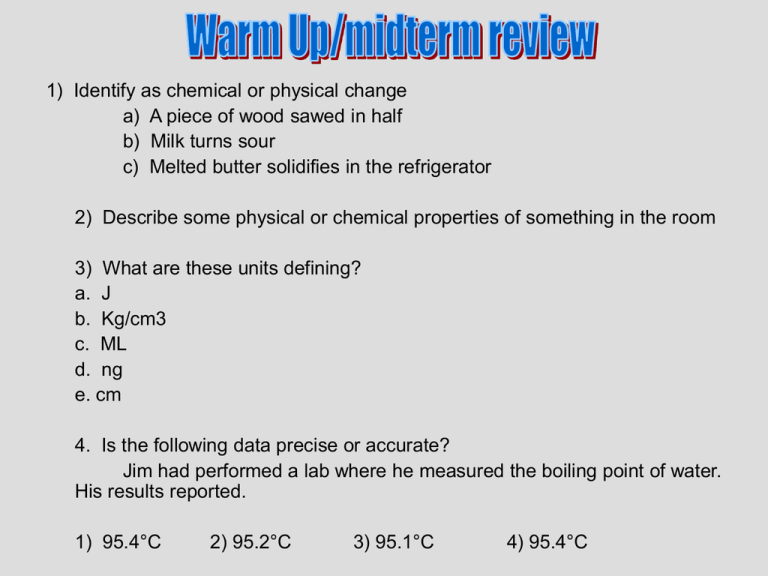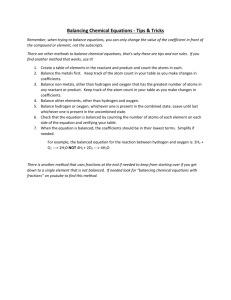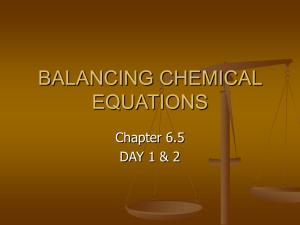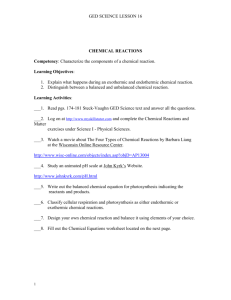Chemical Reactions
advertisement

1) Identify as chemical or physical change a) A piece of wood sawed in half b) Milk turns sour c) Melted butter solidifies in the refrigerator 2) Describe some physical or chemical properties of something in the room 3) What are these units defining? a. J b. Kg/cm3 c. ML d. ng e. cm 4. Is the following data precise or accurate? Jim had performed a lab where he measured the boiling point of water. His results reported. 1) 95.4°C 2) 95.2°C 3) 95.1°C 4) 95.4°C 1) Explain Rutherford’s Gold Foil E 2) Describe some physical or chemical properties of something in the room 3) What are these units defining? a. J b. Kg/cm3 c. ML d. ng e. cm 4. Is the following data precise or accurate? Jim had performed a lab where he measured the boiling point of water. His results reported. 1) 95.4°C 2) 95.2°C 3) 95.1°C 4) 95.4°C Acetic acid is the important ingredient in vinegar. It is composed only of carbon (40.4%), hydrogen (6.71 %), and oxygen (53.28%). It molar mass is 60.1 g/mol. Determine the empirical and molecular formula of the acid. Chapter 8 Section 1 Describing Chemical Reactions Characteristics of Chemical Equations, continued Word and Formula Equations • The first step in writing a chemical equation is to identify the facts to be represented. • A word equation is an equation in which the reactants and products in a chemical reaction are represented by words. • A word equation is qualitative • example: methane + oxygen carbon dioxide + water Chapter 8 Section 1 Describing Chemical Reactions Characteristics of Chemical Equations, continued Word and Formula Equations, continued • The next step in writing a correct chemical equation is to replace the names of the reactants and products with appropriate symbols and formulas. • A formula equation represents the reactants and products of a chemical reaction by their symbols or formulas. • example: The formula equation for the reaction of methane and oxygen is CH4(g) + O2(g) CO2(g) + H2O(g) (not balanced) Chapter 8 Section 1 Describing Chemical Reactions Characteristics of Chemical Equations, continued Sample Problem B Translate the following chemical equation into a sentence: BaCl2(aq) + Na2CrO4(aq) BaCrO4(s) + 2NaCl(aq) Chapter 8 Section 1 Describing Chemical Reactions Elements That Normally Exist as Diatomic Molecules Chapter 8 Section 1 Describing Chemical Reactions Symbols Used in Chemical Equations Does the formula begin with H? Does the Yes acid contain a polyatomic ion? Is the name end in -ate or -ite No The prefix is Hydro and the end of the second element is changed to ic The -ate changes to –ic. H2SO4 Sulfuric Acid HCl is hydrochloric acid The –ite changes to –ous. HNO2 Nitrous Acid According to the Law of Conservation of Mass……matter can not be created or destroyed. We use this rule when writing our chemical equations. Chemical Equations are like recipes for cooking. We have ingredients aka reactants and our products. Cereal + Milk Breakfast H2(g) + O2(g) H2O(l) When we write balanced equations: atoms in the reactants = atoms in the products. H2 + O2 How many atoms in the following 1. H2SO4 2 Hydrogen, 1 Sulfur 4 oxygen 2. Al2(SO4)3 2 x Al, 3 x Sulfur, 12 x Oxygen Today in Chemistry Have out: 1) Materials for notes 2) Goggles HW 1) HW Chemical Reaction Worksheet 2) Empirical Formula lab write up due Monday Today’s Goals 1) Review balancing equations 2) Learn to predict products of a chemical reaction 3) Learn to identify chemical reactions as one of the main 5 reaction types. 1) 2) 3) 4) 5) Synthesis Decomposition Single Displacement Double Displacement Combustion Is this equation balanced? H2(g) + O2(g) H2O(l) Count the atoms Element Hydrogen Oxygen Reactant 2 2 Product 2 1 NO! Not balanced We balance reactions by using coefficients. 2 2 __H 2 +__O2 __H 2O Adding coefficients is the only way to add atoms to an equation. Element Hydrogen Oxygen Remember to distribute the coefficient to all atoms in the compound Reactant Product 2 2 4 2 1 4 NO! Not balanced 2 Let’s try another 2 2 __K +__Cl2 __KCl Element Reactant Potassium 1 Chlorine 2 2 Product 1 1 2 2 • How many atoms of each element in the following? 1) 5H2 2) 10H2O 3) 3Mg3(PO4)2 Practice! O2 + PCl3 POCl3 Chapter 8 Section 1 Describing Chemical Reactions Characteristics of Chemical Equations, continued Sample Problem A If elemental chloride gas is bubbled through a solution of potassium iodide, the iodide ion is converted to elemental iodine, which may be recovered as a gray solid, leaving a solution of potassium chloride. Write the balanced equation and identify the reaction type. When a mixture of powdered gray zinc metal and powdered yellow sulfur is heated strongly, a spectacular reaction occurs, and white zinc sulfide solid is produced. Write the balanced equation and identify the reaction type. Synthesis Reaction - Taking two pieces and forming one large piece. Two lone dancers form a couple A + B AB Mg + O2 Decomposition Reaction - Taking one piece and breaking it down to two pieces. Now when the dances is over. The couple splits. AB A + B NI3 Single Displacement Reaction – Where one element replaces another element in a compound. Metal (Cation) replaces Metal (Cation) or visa versa. A lone dancer cuts in on the couple. AB + C CB + A Fe2O3 + Al “A” or “B” can also be a polyatomic ion Double Displacement Reaction – Where two elements change places in a chemical reaction. Cation Switches with other cation. The couples swap partners. AB + CD AD + CB Hg(NO3)2 + KI Combustion Reaction – Where elements react with Oxygen (O2) produce CO2 and H2O. Now the couple is set on fire leaving water and carbon dioxide. A + O2 CO2+ H2O CH4 + O2




